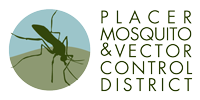
Yellowjackets in Placer County
Yellowjackets are medium-sized black and yellow wasps that are often confused with honeybees, paper wasps and mud-daubers.
Yellowjackets can be public health pests because they commonly nest and forage close to people. Because of their territorial behavior and affinity for human food, yellowjackets can restrict or prevent outdoor activities in areas such as campgrounds, picnic areas, and backyards. Unlike honeybees, yellowjackets do not leave a stinger behind, allowing them to be able to sting multiple times. Stings are painful and can be life-threatening in some cases.
Yellowjackets are social wasps living in colonies that can contain many hundreds of individuals. Colonies are established every year and abandoned completely as they die off in the fall. Queens overwinter and emerge in early spring to begin new colonies. Nests can be established in trees, the ground, or in other existing cavities such as abandoned rodent burrows, the wall spaces behind an exterior wall and the hollows of children’s play equipment. Nests are made of paper produced by chewing up wood pulp. Populations increase rapidly from spring through early fall. During this period of the year, yellowjackets will feed on insects, as well as scavenge for sweet and protein-rich foods.
Yellowjacket Life Cycle

Photo courtesy of Napa County Mosquito Abatement District
Yellowjacket Prevention and Trapping
Prevention
- When dining outdoors, cover food and beverages to discourage yellowjackets.
- Keep garbage cans closed with tight-fitting lids, rinse bottles and cans before placing in covered recycling bins.
- AVOID the area and DO NOT DISTURB the nest.
- If You are Stung by a Yellowjacket:
- Get away from the area.
- If a stinger is visible, remove it immediately.
- Apply cold water or ice in a wet cloth to the affected area.
- If you are allergic to yellowjackets or experience dizziness, difficulty breathing, widespread swelling or other symptoms of concern, call 911 immediately.
Trapping
Lure traps are available for purchase at many retail stores that sell pest control supplies. While lure traps don’t eliminate large populations, they can help reduce the number of localized foraging workers in specific areas like patios, picnic tables or dumpsters. Traps should be placed at the property line or about 200 feet away from the patio or area of to be protected, whichever is farther. Follow all instructions that come with the purchased trap.
Integrated Yellowjacket Management
The District will respond to reports of high yellowjacket activity where a stinging risk is present. Technicians will inspect the area and decide if control is appropriate and possible. Control measures may include placing traps or bait, treating nests with an approved insecticide or physically removing the nest. All pesticide applications are made by state-certified technicians using Environmental Protection Agency approved materials.
If you can safely determine the nest’s location, whether in a tree or in the ground, please let us know when you submit your problem report.
For more information, click here to download our brochure about yellowjackets.
Paper Wasps
Yellowjackets are often confused with paper wasps.
Size and Appearance
Paper wasps have slender, segmented bodies with a thin waist and orange-tipped antennae.
Yellowjackets have short, thick bodies with black or black and yellow antennae.
Behavior
Paper wasps are rarely aggressive but can sting if provoked. They are considered beneficial because they prey on other insects such as spiders. Paper wasps do not swarm like yellowjackets.
Legs
Paper wasps dangle their long legs when they fly.
Yellowjackets tuck their legs under their bodies when they fly.
Nest
One of the easier ways to tell paper wasps from yellowjackets is the appearance of their nests.
Paper wasp nests and yellowjacket nests are both made out of paper, but they look strikingly different. Paper wasps have smaller nests with each cell having an opening to the outside. The nests are often found under eaves or roof tiles. To prevent paper wasps around your home, look for the nests in the springtime and use a high-pressure hose to knock each nest down while it’s small. Most of the time this will discourage paper wasps.
Yellowjacket nests are enveloped with layers of paper material, usually leaving only one entrance and exit to the nest. Most yellowjacket nests in Placer County are built underground, making them difficult to locate






